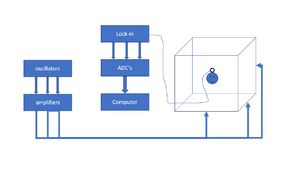Auditory Motion lab technical info
Introduction
The Auditory Motion Lab is a facility designed for experiments involving moving sound sources. The lab features a soundproof booth, ensuring an isolated testing environment. At the heart of the lab is a two-axis robot arm suspended from the ceiling. This arm is equipped with a high-fidelity speaker capable of moving at a fixed distance around the subject's head. The centrally placed chair, which can rotate on its vertical axis, allows subjects to experience sound from various angles. Head movements are tracked using a 3-axis electromagnetic field (EMF) head tracking system. Additionally, wall-mounted speakers facing the subject provide ambient or background sounds to enrich the experimental scenarios.
Booth
- Dimensions: LxWxH = 420x300x285cm
The sound booth is an acoustically isolated room with sound absorbing materials on all walls and the floor to reduce reverberation. A 2.4 m diameter quarter sphere build of a metal structure holds 43 small passive speakers. The speakers also contain two color LED's. In the center of the booth there is a chair for a subject. The chair is placed in a way that the head of the subject is right in center of the sphere. Large coils are embedded in the walls of the sound booth. The coils make a box of about 2.5 m x 2.3 m x 2.8 m. These coils are used for head movement detection.
An infrared camera is installed in the booth. The experimenter has a monitor from which he/she can see the inside of the booth. The camera looks down on the back of the subject.
Acoustics
The Booth is acoustically isolated from its environment. The walls and corners are covered by acoustic materials.
- Walls: egg box type soundproofing foam
- Floor: anti-fatigue rubber floor mat with holes
Computer
A windows computer with MATLAB, RPvdsEx and zBUSmon. The computer has an optical interface card (PO5e) for communication with the Tucker Davis equipment via the Optibit optical bus (FO5) at the back of the rack. The working of the optical bus can be monitored by the program zBUSmon program from TDT. This program has also some control functions for the optical bus. It shows all the connected zBus chassis and the TDT devices that are installed in each chassis. It also shows the version number of the installed firmware on the devices.
Software
TODO
<name of the program>
The programming of the RZ6 is based on the BIOX toolbox.
RPvdsX software
The BIOX sofware can be found in the \biofysica\experiment\biox_rz6 directory.
Electronics rack

From top to bottom:
- Patch Panel Audio Wall
- 3x quad-channel audio amplifier
- 24 channel Motu sound processor
- Zbus caddy: Left=empty; Right=Patch Panel Arm Speakers
- RZ6 MUlti I/O Processor
- Patch Panel RZ6 Digital-I/O
- Zbus caddy: Left=empty; Right= 6 channel ADC
- Frame: Left=empty; Right= Patch panel for 6 channel ADC
- Robot arm manual user interface
- Digital Eventrecorder
- Oscilloscope
- Field coil generator (amplifier)
- Femto Lock-in amplifier module
Sound system
There is a primary sound system with speakers on the robot arm and a secondary sound system with speakers on the wall. The purpose of the primary system is to provide moving sound stimuli. the purpose of the secondary sound system is to provide background sounds or noise.
Primary sound system
The primary sound system consists of a programmable sound processor (RZ6) with each two DAC’s. The RZ6 generates a sound signal that travels to a patch panel inside the booth and from there to two speakers on the robot arm.
Speaker specifications:
- Sensitivity: 86 dB SPL (@2.83 Vrms input)
- Frequency response: 150 Hz-20 kHz
- Impedance: 8 Ohms
- H x W x D: 78 x 78 x 85 mm
- Weight: 0.43 kg
The speakers are connected via 2 lead wires for the sound and 3 lead wires for the LED's.
Secondary sound system
%todo
LED system
%todo
%todo
Parts
- Trigger from RZ6
- Custom LED controllers (2x)
- LED mounting frames (32x)
- Red/Green LED’s (32x)
Specifications Red/Green LEDs
- Bivar 5BC-3-CA-F (Common Anode)
- Red 625nm (FWHM = 25 nm)
- Green 568 nm (FWHM = 30 nm)
- Nominal current 20 mA
- Voltage drop 2.1V
- 45 degree viewing angle
- Series resistor 1kOhm
- Actual current 10 mA @100% PWM
Trigger/Timing system
Parts
%todo
- Pushbutton (passive switch, normally open)
- RZ6 Buttonbox (4 passive switches, normally open; 4 led indicators)
- Digital event recorder
Specification
%todo
Head Tracking System
The EM Field Head Tracking System is used for recording head movements of the subject during a trial. The system consists of the following parts:

- Three oscillators at roughly 50, 60 and 70 kHz for X, Y and Z direction.
- Three signal amplifiers that amplify the oscillator signals.
- six field coils that make a cube of roughly 3x3x3 meters.
- A small pick-up coil mounted on a glasses frame that is worn by the subject during the experiment.
- Three lock-in amplifiers that split the signal from the pick-up coil in the 3 frequency components and measures their envelope. They output analog signals between -10V and +10V.
- An acquisition device converts the analog output signals from the lock-in amplifiers to digital.
- A RZ6 multi I/O processor that records the acquired data.
- Software that converts the recorded data to head orientations using calibration data.
The following table contains the channel convention with respect of the three directions:
| Channel | Frequency | Orientation | Color | Polarity |
|---|---|---|---|---|
| Channel 1 | 50 kHz | Frontal | Red | Front = positive; Back = negative |
| Channel 2 | 60 kHz | Vertical | Blue | Right = positive; Left = negative |
| Channel 3 | 70 kHz | Horizontal | Yellow | Up = positive; Down = negative |
Lock-in amplifiers
%todo [RobotLab Lockin Settings.JPEG|Lock-in amplifier settings]
settings: